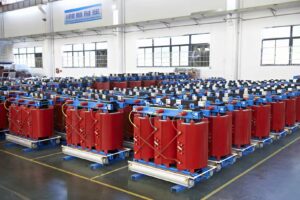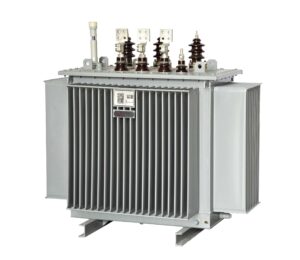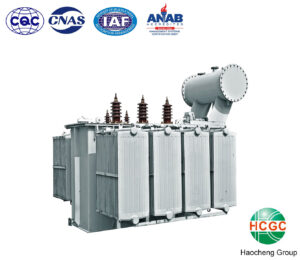Comparison Between Dry Type Transformers and Oil Immersed Transformers
Dry-type transformers and oil-immersed transformers are the two most widely used transformer types in power systems. The core difference between them lies in the different insulation and cooling media used, which leads to a series of significant differences in their structure, performance, application scenarios and maintenance requirements.
Comparison between Dry-Type and Oil-Immersed Transformers
- Insulation and Cooling Media:
Dry-type transformers use air as the primary insulation and cooling medium, or they use solid insulating materials (such as epoxy resin casting, Nomex paper, or varnished fiberglass) to encase the windings and provide insulation. Heat dissipation primarily relies on convection between the windings and core and the surrounding air. Forced air cooling fans are sometimes used.
Oil-Immersed Transformers: Use transformer oil (usually mineral oil, but also synthetic esters or silicone oils) as the primary insulating and cooling medium. The windings and core are completely immersed in the oil. Oil not only provides excellent insulating properties, but its fluidity and high heat capacity make it an excellent coolant. Heat is dissipated to the air through natural convection or forced circulation of the oil (via an oil pump and radiator/cooler).
- Heat Dissipation and Overload Capacity:
Dry-Type: The thermal conductivity of air or solid materials is much lower than that of oil, resulting in lower heat dissipation efficiency and relatively poor overload capacity. Temperature rise limits are the primary limiting factor.
Oil-Immersed: Transformer oil has a high heat capacity and excellent fluidity, resulting in extremely high heat dissipation efficiency. This gives oil-immersed transformers greater short-term overload capacity and greater tolerance to load fluctuations.
- Capacity and Voltage Levels:
Dry-type transformers: Limited by heat dissipation capabilities, they are typically used on the distribution side of medium and low voltage (≤35kV) and have relatively small capacities (usually under 20MVA). While larger capacity dry-type transformers are available, they present greater economic and heat dissipation challenges.
Oil-immersed transformers: Their heat dissipation advantages give them an absolute advantage in high voltage (up to ultra-high voltage and ultra-high voltage) and large capacities (hundreds of MVA or even greater), making them the preferred main grid transformer for transmission and transformation systems.
- Fire Safety and Environment:
Dry-type: Highly fire-safe. Uses flame-retardant or flame-retardant solid insulation materials and contains no flammable liquids. Even in the event of an internal failure, the probability of fire and the risk of fire spread are relatively low. There is no risk of oil leakage or contamination. Therefore, it is particularly suitable for installation indoors, in densely populated areas, and in locations with strict fire safety requirements (such as commercial centers, hospitals, schools, subways, high-rise buildings, chemical plants, mines, etc.).
Oil-immersed transformers: Transformer oil (especially mineral oil) is a flammable liquid. Internal faults (such as arcing) can cause the oil to decompose, generating flammable gases, which can even cause fire or explosion (despite the presence of pressure relief devices and relay protection). There is a risk of oil leakage contaminating soil and water sources. Transformers are typically installed outdoors or in a separate, fire- and explosion-proof room with facilities such as oil storage pits and firewalls. Synthetic ester oil (natural ester oil) has a high flash point and is biodegradable, making it more environmentally friendly and safer than mineral oil, but it is more expensive.
- Maintenance Requirements:
Dry-type: Maintenance is relatively simple. Key tasks include regular cleaning (to prevent dust accumulation that affects heat dissipation), inspection of fasteners and connections, and monitoring of temperature and operating sound levels. No oil handling is required.
Oil-immersed: Maintenance requirements are higher and more complex. Regular monitoring of oil level and temperature is required, and oil samples must be taken for oil chromatography analysis (to detect dissolved gases to diagnose potential internal faults) and oil testing (to assess oil quality and insulation paper aging by testing for moisture content, acidity, dielectric strength, and furfural). Seals must be inspected to prevent leaks, and oil filtering or replacement may be necessary.
- Other Aspects:
Noise: Dry-type transformers are generally quieter (especially without forced air cooling). Oil-immersed transformers typically have a higher overall noise level due to the electromagnetic noise of the transformer itself, combined with the noise from the cooling fan and oil pump.
Weight and Volume: For the same capacity, oil-immersed transformers are generally heavier and larger than dry-type transformers (due to the need to accommodate the oil and heat sink).
Initial Cost: For the same capacity and voltage level, the initial purchase cost of a dry-type transformer is generally higher than that of an oil-immersed transformer.
Lifespan: The lifespan of both types of transformers is affected by the aging of the insulation material. The lifespan of oil-immersed transformers is largely determined by the aging of the insulation paper (affected by temperature, moisture, and oxygen), while the lifespan of dry-type transformers is largely determined by the aging of the solid insulation material (such as epoxy resin and Nomex). With good maintenance, both types can achieve 20-30 years or even longer.
Summary and Selection Recommendations:
Choose a dry-type transformer:
When fire safety is paramount (indoor installation, in crowded areas, or in flammable and explosive environments).
When environmental protection requirements are stringent and the risk of oil leakage is unacceptable.
When installation space imposes strict weight and volume restrictions (although dry-type transformers may be larger per unit capacity than oil-based transformers).
When ease of maintenance is crucial (complex oil management is undesirable).
Apply to medium and low voltage distribution systems with moderate capacity requirements (such as power distribution in buildings, factory workshops, and renewable energy integration).
Choose an oil-immersed transformer:
When high voltage and large capacity are required (main grid transmission and transformation, large power plants, and large industrial and mining enterprise step-down stations).
When high overload capacity is required.
When initial cost is the primary driver and the installation environment permits (outdoors or in a separate fireproof transformer room).
When operating noise requirements are relatively relaxed.
Applicable to outdoor substations, centralized large-scale distribution centers, etc.
Simply put: dry-type transformers are safe, environmentally friendly, and maintenance-free, making them suitable for indoor power distribution. They are the preferred or only choice in locations where fire, explosion, and environmental protection are mandatory or stringent requirements. Oil-based transformers excel in heat dissipation and large capacity, forming the backbone of power grids, but require attention to fire prevention and maintenance. There’s no absolute winner; the key lies in a comprehensive evaluation and selection based on factors such as the specific application scenario, capacity and voltage requirements, safety and environmental protection requirements, budget, and maintenance capabilities.



